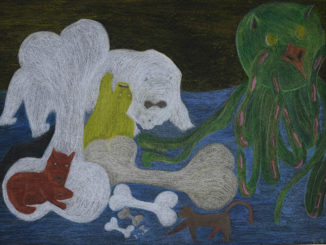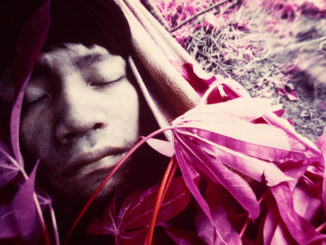 Enrique Martínez Celaya, a visual artist whose work is associated with the nature of human experience and the search for meaning that dominates so many contemporary societies, was a late bloomer. His interest in artistic expression began in his childhood, but art did not become his profession until well into his twenties. Painting was the starting point of his career, whose possibilities and limits he quickly expanded, crossing traditionally pictorial boundaries into other media like sculpture, installation, and photography. Set in the transient world of time and memory, identity and displacement, Martínez Celaya’s work embodies his belief that being a certain kind of artist means being a certain kind of person and that in and through art one gains clarity about himself and his relationship to the world.
Enrique Martínez Celaya, a visual artist whose work is associated with the nature of human experience and the search for meaning that dominates so many contemporary societies, was a late bloomer. His interest in artistic expression began in his childhood, but art did not become his profession until well into his twenties. Painting was the starting point of his career, whose possibilities and limits he quickly expanded, crossing traditionally pictorial boundaries into other media like sculpture, installation, and photography. Set in the transient world of time and memory, identity and displacement, Martínez Celaya’s work embodies his belief that being a certain kind of artist means being a certain kind of person and that in and through art one gains clarity about himself and his relationship to the world.
Born in Cuba in 1964, the artist immigrated with his family to Spain, where in the face of the limitations of exile he turned his attention to drawing. Later settling in Puerto Rico he was apprenticed as a painter at the La Liga Del Arte del San Juan Academy, learning techniques in pastels and oil. The quests for cultural and religious identity are recurrent keynotes of his work.
“Many people in Miami share my sense of displacement, of being between worlds, and of trying to sort out life in relationship to geography,” he observed. “Here, homesickness, exile and rootlessness, are more prevalent than in any other city I know. That might be why, in some ways, Miami is more an idea than a place.”
In 1982 Martínez Celaya received a Master’s degree in applied physics and electrical engineering from Cornell University, and soon followed on a Ph.D. track in science at the University of California, Berkeley. But art had become deeply rooted in his imagination and soon after finishing his Master’s degree in quantum electronics he decided to turn back to it by pursuing graduate work in fine arts in painting and sculpture at the University of California in Santa Barbara.
And he passionately took the leap and built a new career, embracing the art scene with an identity combining scientific discipline and unconventional approach, often using unorthodox materials such as blood, feathers, and tar in his painting. Martínez Celaya’s original solo installations have filled spaces from the Metropolitan Museum of Art to the Museum der Bildenden Kunste in Leipzi, Germany, including a recent commission for the New York City’s Cathedral Church of Saint John the Divine.
“I am grateful for my background in science. For better or for worse, physics is rigorous; something the art world is usually not,” he said. “Science has also affected my relationship to the world by suggesting everything has a structure, and also that what we see is not what it might be. Or, more importantly, that what it might be is likely out of reach.”
Last year, Martínez Celaya launched Whale & Star, an 18,000 square foot art studio in the heart of the Wynwood Art District. The artist’s workspace includes several areas, the rooms of his private collection, a library, and an archive room, consisting of sketchbooks, notes, manuscripts, sketches of major commissions, photographs, image databases, architectural models for exhibitions, and scientific papers. The art space has given Martínez Celaya and his team the opportunity to engage in a continuous exchange and dialogue within the local community.
The studio’s agenda includes a lecture series, a public extension of the concerns that animate Martínez Celaya’s work. The program brings leading critics, curators, and scholars to the studio to lecture on art’s relationship to life, including art’s ethical implications. To date the lectures have focused on the work of artists, including Donald Judd, Yves Klein, and David Smith, as well as philosophers, such as Friedrich Nietzsche. Another outreach program, the summer workshop in affiliation with the Anderson Ranch Arts Center in Colorado, gives emerging to mid-career artists the opportunity to be immersed in an intense week of critiques and discussions spanning historical, theoretical, and practical perspectives of artistic practices.
“I believe in teaching because I benefited from my mother’s emphasis on education and the love of a dozen great teachers. The American educational system is in decline, and like other social issues, the problems are most severe for the poorest children in the country,” he said. “The cynical poll-tested efforts of politicians towards these problems usually emphasize science and math, not because they love the subjects, but because they fear China, so the arts don’t stand a chance. I am grateful for the few good art teachers who remain committed to art as a substantial, critical, and emotional endeavor. But being a father confirms how often a clumsy artistic education based on whimsy, artiness, and moral incertitude, extinguishes the spark we see in the drawing of children.”
Martínez Celaya’s named his art studio after its imprint, Whale & Star Press, founded in 1988. The house publishes two to three titles a year in art, poetry, art practice, and critical theory through five different series, distributed nationally and internationally by the University of Nebraska Press, where Martínez Celaya is a visiting presidential professor.
When asked about how Miami has influenced his art, he said he is not in touch with the local Latino art scene and that in his own work he prefers to avoid narratives – his or anyone else’s – of what the city is about or how it contributes to his projects.
But other artists have engaged in capturing and developing the relationship between Miami and Martínez Celaya’s insights, whether consciously or in parallel projects that explore his imagery and undercurrent themes, especially that of something getting uprooted and placed, out of context, somewhere else. Mary Rakow, a doctor of theology, said her residency at the studio was a catalyst for a series of analysis and changes that added to the plot of her novel The Memory Room. She refers to Nomad, one of Martínez Celaya’s most noted works exploring solitude and isolation – featuring four canvases portraying the four seasons, a girl, and a leopard – as a particular source of inspiration.
“I am attracted to work that has a certain kind of ambition. Work where I can feel the person behind the work wrestling with questions that have a certain degree of seriousness,” said Rakow. “You know – that they are engaged in what I would call the most important questions. Like, what is truth? And integrity? Death? Belonging? Memory? Ethical conduct? Love? Sorrow? In other words, work that, without apology, engages in questions of meaning. Not that one finds answers. Enrique’s work is not a manifesto, and neither is mine. But you can engage in a kind of discourse that is the deepest kind of discourse I know, and the one that calls for my deepest attention.”
Martínez Celaya’s works structured around concepts relating to theology and a complex inner life were also influential in Rakow’s composition of The Memory Room.
“This way of trying to fashion a link between inner and outer, between one’s deepest self and the world of others, and to cross over that danger and risk,” she explained. “And this is what “the Miami art city” means to me, I suppose. Fragility and rigor, risk and beauty all intertwined.”
As for future projects Martínez Celaya, who says that in paintings he favors oil mixed with wax or watercolors, and in sculpture “everything but Tiffany boxes” has just released two sculptures: The Gambler and The Tower in bronze, which will be going to various shows this year in Sydney, Los Angeles, Berlin, Moscow, and Barcelona. Also this year, he will be re-installing Schneebett, which was originally created for the Berliner Philharmonie, at the Miami Art Museum and is currently working on an opera in collaboration with New York based composer Brian Mountford, based on Oscar Wilde’s story The Happy Prince.
When asked how his art reflects his personality, Martínez Celaya said that each project is an invitation to explore and push his own boundaries, his work serving a medium to tell his own story. “I’m tired of my personality, but it is not easy to get away from it, and this is true in the work as well. Although people hold on to what one has said or done, in art, to know what one is about leads to nowhere good. So it is best to keep things moving and confusing.”



Be the first to comment